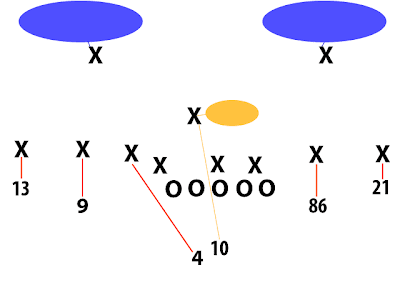I’m not going to pin this on Mark Snyder, because if he wrote the headline, I’d be surprised, but “Ex-quarterback Threet gives starting nod to Sheridan in spread offense” is really, really not what’s going on in this article:
“I feel like Tate has a good opportunity coming in early with the extra reps in the spring and that should be beneficial,” he said. “But Nick does a good job of executing the offense the way they want it to be run. People may point out the physical things Tate or Denard may have at a physical advantage, but a lot of time at quarterback in this system comes down to decision-making.”
Is it just me, or does that quote have a whole lot more “Hey, I’ll be impartial and not endorse anyone. Now leave me alone and let me go to Arizona State” than “I decree that Nick Sheridan shall be the starter” ? I’d have to go with a lot more of Option B. Before the internets go crazy on this, look at what Threet actually said, and not so much the headline of the article.
Of course, most Michigan fans at this point are willing to endorse Tate Forcier for obvious reasons:
But honestly, whichever quarterback wins the job, be it Forcier, Sheridan, or Denard Robinson, that’s my guy. Primarily because I don’t have a say. People criticized Rich Rodriguez (and perhaps rightly so) for starting Sheridan over Threet last year, and while Threet may have been better, he certainly wasn’t head and shoulders above Sheridan.
All that’s left is the waiting…



 Michigan is on the right hash in a basic spread set. Brandon Minor is the running back to Steven Threet’s left. Greg Mathews and Junior Hemingway are the wideouts to the left and right, respectively. In the left slot is Martavious Odoms. At slot on the right side is tight end Kevin Koger, appearing in a game for the first time this year. Wisconsin counters with a 3-2-6 dime package. The four CB/Nickel players are head up over the receivers. The linebackers are head up over Threet and Minor. The two safeties are deep.
Michigan is on the right hash in a basic spread set. Brandon Minor is the running back to Steven Threet’s left. Greg Mathews and Junior Hemingway are the wideouts to the left and right, respectively. In the left slot is Martavious Odoms. At slot on the right side is tight end Kevin Koger, appearing in a game for the first time this year. Wisconsin counters with a 3-2-6 dime package. The four CB/Nickel players are head up over the receivers. The linebackers are head up over Threet and Minor. The two safeties are deep. At the snap, Threet takes a 3-step drop. Minor sets as though he’s pass blocking, though Wisconsin only comes on a three-man rush. Free of the duty of protecting Threet, Minor runs a short circle route out of the backfield. Odoms runs a 10-yard stop route. The other three receivers all run vertical routes, with Mathews and Hemingway on fly routes down the sideline, and Koger running a seam down the middle.
At the snap, Threet takes a 3-step drop. Minor sets as though he’s pass blocking, though Wisconsin only comes on a three-man rush. Free of the duty of protecting Threet, Minor runs a short circle route out of the backfield. Odoms runs a 10-yard stop route. The other three receivers all run vertical routes, with Mathews and Hemingway on fly routes down the sideline, and Koger running a seam down the middle.
 Wisconsin rushes the three linemen, runs man coverage on the receivers (and backs, including a spy on Threet), and has two safeties taking deep halves over the top. Threet goes deep to Koger, who is behind his defender. Koger makes the catch at the 6, and isn’t hit by a safety until after he’s in the endzone.
Wisconsin rushes the three linemen, runs man coverage on the receivers (and backs, including a spy on Threet), and has two safeties taking deep halves over the top. Threet goes deep to Koger, who is behind his defender. Koger makes the catch at the 6, and isn’t hit by a safety until after he’s in the endzone.




